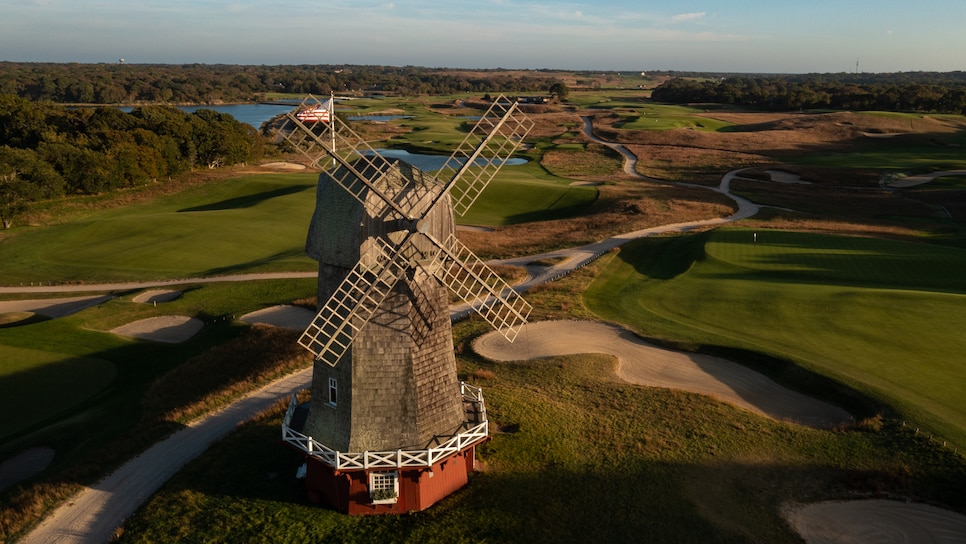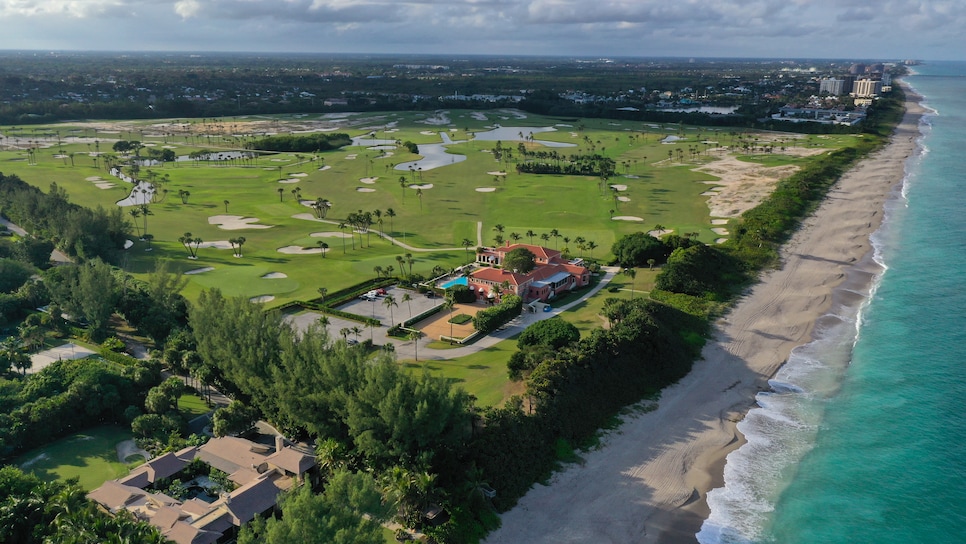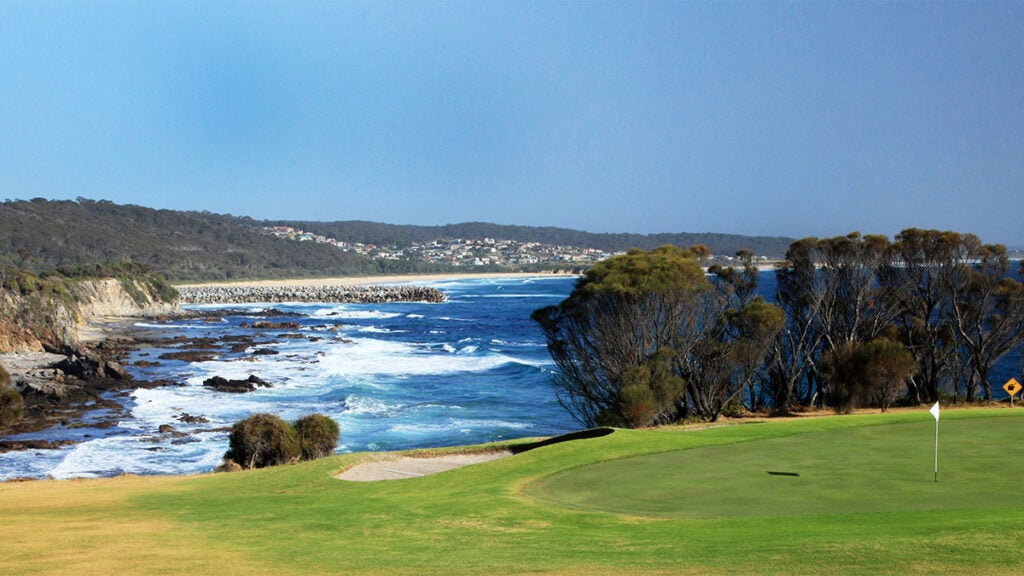[Photo: Golf Digest US]
It was an offer too good to be true, proposed in the form of a question that feels rather rhetorical. Would the USGA have any interest in bringing the Walker Cup to Cypress Point Club?
OTHER NEWS: Ryder Cup 2025: Sergio Garcia WDs from Irish Open, citing disappointing European team snub
Nine years ago, Peter Barker, Cypress Point’s then-club president, broached the subject with Mike Davis, the USGA’s executive director at the time. The two were playing in one of the California club’s member-guest tournaments, the Hook and Eye. Barker did attach one stipulation: The club would not make any changes to the course to accommodate the event (He didn’t want it to become an excuse to lengthen the course).
As Barker recalls it, he mentioned the idea on the first hole as he and Davis were starting a round, and on the 10th tee, Davis put his arm around Barker’s shoulder and said “We’re in.”
Davis remembers the two essentially having an informal agreement in place that night after going to Barker’s house and watching a VHS tape of the 1981 Walker Cup, the previous time the match visited the Monterey Peninsula.
The only potential issue going forward was the fact the next available Walker Cup in the United States wasn’t until 2025, but even that wasn’t quite the hurdle it might have appeared. As it turns out, 2025 marks 100 years since Cypress Point’s founding.
And so it is that one of the most prestigious amateur golf events in the world will be held on one of the most beautiful golf courses in the world. The 10 top players from the US will face their 10 counterparts from Great Britain & Ireland in a two-day event that will be played for the 50th time.
For Cypress Point, which hasn’t hosted a national event of such prestige since it dropped out of the rotation of courses for the PGA Tour’s AT&T Pebble Beach Pro-Am in 1990, it allows the club to showcase the famed Alister Mackenzie course, No. 3 in Golf Digest’s America’s 100 Greatest Courses ranking, to the world once more. While the venue isn’t big enough to host a professional event, it can accommodate 4,100 spectators who’ll get to walk the fairways (from a sold-out ticket allotment) and prove that even at its modest 6,620 yards (6,053 metres), its sublime mix of woods, dunes and ocean still holds up against some of the finest players in the world. And with no PGA Tour or LPGA event scheduled for this week, the Walker Cup at Cypress will have the stage to itself with golf fans getting the treat of having Golf Channel broadcast Saturday and Sunday afternoon singles play during prime time on the East Coast (US time/Sunday and Monday morning AEST).
According to Barker, who serves as the Walker Cup general chairman, hosting the competition allows Cypress Point to accomplish something even more meaningful.
“We think we have a responsibility to share the course [with the golf world],” says Barker, who took inspiration from when National Golf Links hosted the 2013 Walker Cup. “We’re proud of this venue and sharing it was something we feel is appropriate with the game of golf.”

The National Golf Links. Picture: Golf Digest US
The lineup of courses that have hosted the Walker Cup, such as National Golf Links in 2013, or will in the near future, is an as good as any golf event in the world, says former USGA executive director Mike Davis, including the US Open and Open Championship.

Seminole Golf Club was site of a US win in 2021. Carlos Amoedo

Pine Valley hosted the Walker Cup in 1936 and 1985, and is scheduled to do so again in 2044. Picture: Golf Digest US
It’s a theme you hear from officials at other highly acclaimed courses that that been recent Walker Cup sites. According to Davis, when he mentioned to Seminole Golf Club president Jimmy Dunne the idea of hosting the 2021 Walker Cup, Dunne said to give him 24 hours. That day later, he gave Davis the green light.
“I liken it to classic cars,” Barker said. “These cars were created during the golden age of golf. And there’s been a great passion about restoring those courses and protecting them in their original condition. And the venues that the USGA has been selecting have embraced that. There is something about the history of golf and cherishing those who went before us.”
Needless to say, Cypress Point’s graciousness aligns directly with the USGA’s recent strategy of bringing its premier championships to “the cathedrals of the sport.” You’ve heard a lot about the US Opens going to anchor sites such as Pinehurst, Oakmont and Pebble Beach, locking up venues decades into the future. The same is happening with the US Amateur and Walker Cup.
“We talk a lot internally about how it’s important to players where they win their major,” says Ben Kimball, USGA senior director of championships, who oversees course set-up at the US Amateur and Walker Cup. “And that major could be the US Women’s Mid-Amateur, it could be the US Girls’ Junior, it could be a victorious Walker Cup or Curtis Cup team. You think about us as golfers, it’s natural for us to say, ‘Yes, I played Cypress, yes, I played Seminole.’ Nobody really asks you what you shot. But you want to be associated with the greatest venues in the game if you’re an elite amateur or a professional golfer
“And with the support of the [USGA] executive committee, that’s why we’ve been on this mission from top to bottom. You see it not only in the Walker Cup but the Girls’ Junior and the US Junior Amateur, all these sites. We’re lifting all boats at the same time, which is a good thing.”
RELATED: Ryder Cup 2025: Rahm, Hovland, Aberg highlight European captain’s picks
Indeed, the Walker Cup has been a particular beneficiary. Since 2005, its roster of American host courses has been Chicago Golf Club, Merion, National, Los Angeles CC and Seminole. And after Cypress comes Bandon Dunes (2028), Oakmont (2032), Chicago GC (2036) and Pine Valley (2044).
The R&A also has taken the event to some highly prestigious venues when it hosts every two years, including Royal County Down (2007), Royal Lytham (2015), Royal Liverpool (2019) and the Old Course at St. Andrews (2023). Next year, Lahinch, in Ireland, will host the Walker Cup when it shifts on the calendar to even years after the Ryder Cup moved from even to odd years during the COVID pandemic.
“What event in the world has as good a pedigree of golf courses in the Walker Cup?” Davis says. “I defy anybody to say there’s a better event in golf anywhere in the world that gets better golf courses than the Walker Cup, including the US Open and Open Championship.”
‘We think we have a responsibility to share the course. We’re proud of this venue and sharing it was something we feel is appropriate with the game of golf.’
—Peter Barker, former Cypress Point president and Walker Cup general chair
For today’s competitors, having the Walker Cup at such prestigious venues hasn’t gone unnoticed. Jackson Koivun, the No. 1 ranked amateur in the world, has a PGA Tour card ready for whenever he decides to turn pro. The 20-year-old from Chapel Hill, NC, could have done so in the spring, but decided to come back to Auburn for his junior year. As part of that, Koivun knew that would give him the chance to play in the Walker Cup at Cypress.
“It’s unbelievable,” Koivun says. “I’ve played Cypress a couple of times, and it’s such a cool golf course with some of the greatest views I’ve ever seen in my life. And it’s really cool to be able to compete on that team this year and I’m just really looking forward to.”
Nathan Smith, a three-time Walker Cup player who is captain of the American team this year, says bringing the event to acclaimed courses only makes the experience more prestigious.
“I think it adds to it,” Smith said. “Any time you can have an iconic venue like this, even just to play in it and get the experience here, is amazing. And I think as you get older, the experience is what really matters and how you treat it. They’re going to have the greatest experience of their lives.”
That’s certainly the goal.
Kimball has worked with Cypress Point superintendent Jeff Markow and his maintenance team on the set-up, including placement of fairway lines, the heights of the rough (roughly three inches) green speeds and hole locations. The naturally sandy dunes will stay unmanicured, of course. Listed formally as 6,620 yards (6,053m), just 114 yards (103m) different than 1981, Cypress Point’s overall distance will change daily, Kimball says, with the intention of using alternate tees on holes 8, 9, 17 and 18. As for Cypress Point’s renowned par-3 16th, three of the four sessions it will likely play at its listed 230 yards (210m), with an alternate tee of 211 yards (192m) in the works. Holes 5 and 10 will play as par 4s for an overall course par of 70.
“From the first tee to the final putt on 18, if the matches go that far, this is a course that rewards smart aggression and punishes carelessness without mercy,” Kimball says. “It’s about strategy and control, not just power.” The intention, he says, is “to create a set-up that honours the Walker Cup and the legacy of golf here on the Monterey Peninsula.”
But what about the legacy of the 2025 Walker Cup? When asked what he hoped that might be, Barker took a big-picture perspective.
“I hope the legacy is the same that it’s been for Seminole and LA Country Club, for National,” Barker says. “That you know people are appreciative and understand what a great piece of real estate, what a great competition, what a great spirit of amateur golf that the Walker Cup represents. And that Cypress Point is able to host it in a way that continued with the positive vibrations from that.”




